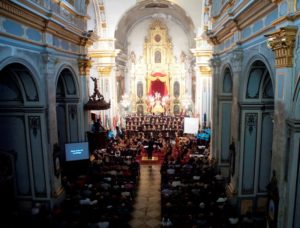Still when parties come, on some balconies, They are adorned with the most important distinctive of our parties, the flag of St. George, and it is that our elders knew how to give the true meaning to the Festival and Saint George, relating it splendidly. But the time, political and social changes, they have been replacing it with others, and something so ours, has remained in a very secondary plane.
I think it is not good to lose the true roots, but if we take into account that these came to cost our ancestors their lives, because according to Don Francisco Berenguer tells us in his book “Bañeres and San Jorge”, in the fights of the war of succession in 1706 says verbatim: (In this last place, more than 4.000 mens, among which there were seven regiments, formed by troops of the Archduke and Portuguese: entered the town and found that their neighbors, in sight of the greatest number of enemies, they had retired to the castle … having received from the allied peoples the help they implored on similar occasions, they put them on the run, not without having died 300 men and caught 20 prisoners, but before, they, seeing that their efforts were useless, they mistreated and disabled the one who was going to ask the other peoples for help, which fell into his hands, they sacked the town, taking away, among other things, the flag of St. George, 3.000 heads of sheep and goats, 113 mounts …)
It is possible that someone is concerned about what our colors and our flag will be and perhaps it has always been the Flag of Saint George. It is still a hypothesis, but it would be necessary to meditate.
The Flag of Saint George, a red cross on white background, has a tradition dating back to 1201 when Pedro II of Aragon, father of King James I, founds the Order of San Jorge de Alfarma, whose insignia is the red cross on white habit.
In the battle of Puig in 1273 the Aragonese carry the banner of Saint George.
Peter III “the Ceremonious” the 3 June 1365, institutes the «Centenar de la Ploma», troop that the city of Valencia had at its service and whose purpose was the custody and escort of the Senyera. The flag of the "Hundred of the Feather", it was rectangular, white with the red cross of Saint George.
Peter himself «the Ceremonious» the 10 of . July 1371 creates in Valencia the Brotherhood of San Jorge with the distinctive of San Jorge.
The Military Orders, assigned to the patronage of St. George, also echo colors and symbols. The Bavarian Order of St. George, very old order, whose grand master is the king. The great commanders, They wear the silver shield with a red cross.
In 1400 the Order of Montesa joins the Military Order of San Jorge de Alfarma, calling itself from this moment of Our Lady of Montesa and San Jorge de Alfarma, taking the flat cross of gules (roja) that knights currently wear in their capitular robes.
England, so attached to Saint George, has great connections with the banner of his employer. There is a distinction that comes from 1818, the Order of St. George of England, whose plate bears a red cross on the white background, and even the flag of the British Empire whose triple cross of the Union Jack, the third superimposed cross is the cross of St. George, red on white background.
Y, how not, towns near us, united to the same patron and to the same party, they tell us about the appearance of Saint George in the book «Celebre Centuria» by Vicente Carbonell, en1672 dice: (It happened that when the day dawned, the Moors committed, who found powerful resistance in the few who were there, with the help of a spirited Knight, that on the walls the Moors saw on a white horse, with a red cross on his chest …)
Or the appearance of Saint George who tells us in “Bañeres and San Jorge” Francisco Berenguer, to the troops of Don Pedro I of Aragon in 1095 ” in the battle of Alcaraz; Saint George appeared mounted on a white horse with a red cross on his chest…”
Own “Sant Jordi el Vellet” He wore on his chest a rectangular white flag with the red cross.
The authentic flag of Saint George, the cross that this transferred to the "turbot" the horizontal arm of the cross must be exactly twice the vertical, because otherwise we will be using the red cross symbol.
Heraldry gives meaning to these colors, as the color gules (Red) it means, fortress, victoria, audacity, the silver color that is expressed with the white color, means purity, integrity, obedience, firmness, surveillance, expiration.
Infinity of stories would relate us to Saint George with his flag and his colors, but it would lead us nowhere, if we did not become aware of what we are losing, of this great tradition of decorating our balconies with the original banner of the Festival and that little by little is being lost. It is the work of everyone and especially of those housewives who with enthusiasm and care prepare the "turbot" to wear it at parties. Also the Festival Commission, the Brotherhood of San Jorge and all those responsible for the Fiesta, They cannot be left out of something that urgently needs their recovery and insertion in the Party.











